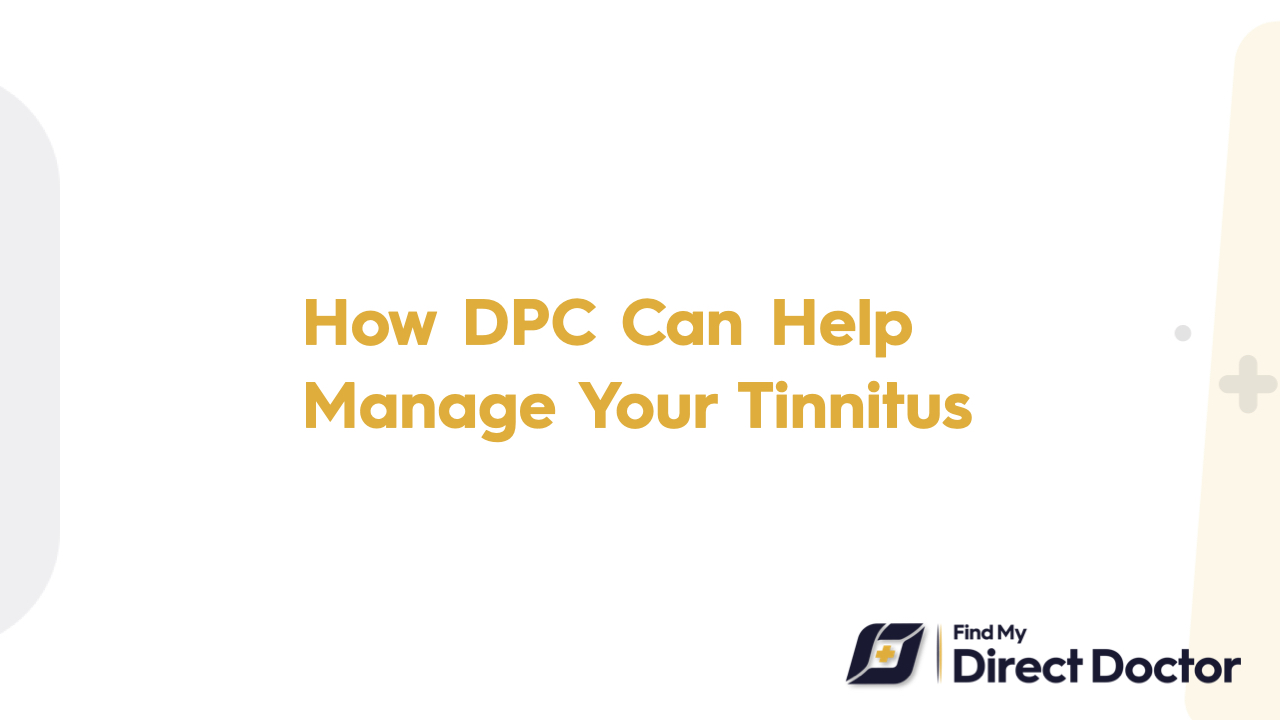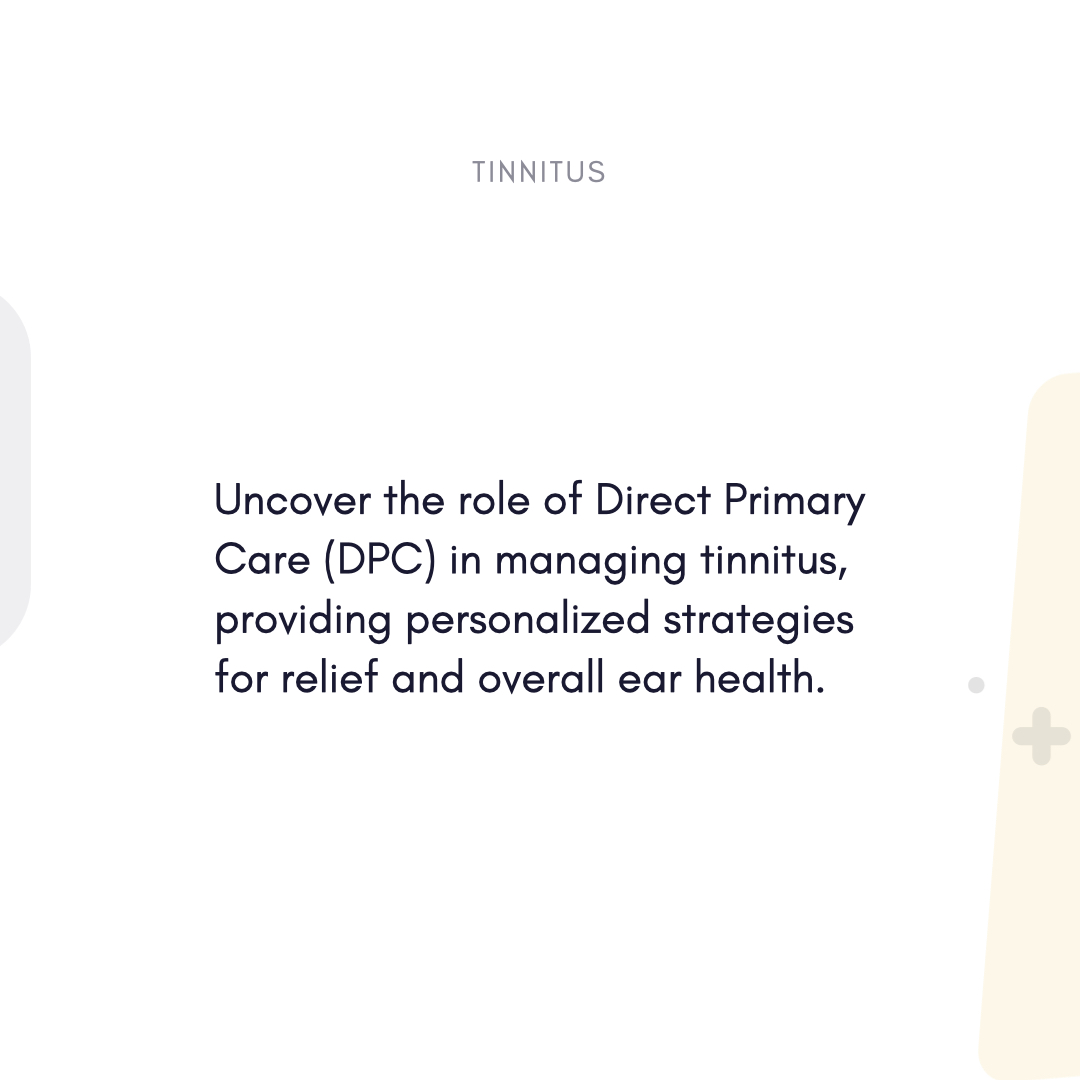Tinnitus and Direct Primary Care (DPC): Personalized Relief for Ringing Ears
You know the aggravation of tinnitus if you have ever suffered the constant ringing, buzzing, or hissing in your ears with no relief. Affecting 50 million Americans, tinnitus can interfere with mental health, concentration, and sleep. Direct Primary Care (DPC), however, presents a patient-centered approach to tinnitus management combining fast evaluation, cost transparency, and techniques to reclaim your quiet.

Dealing with Tinnitus and Its Effects
Tinnitus is the sensation of sound devoid of outside origin. Typical causes range from:
- Noise exposure: headphones, machinery, or concerts.
- Hearing loss related to age: Presbycusis.
- Medical ailments: Meniere's disease, hypertension, or TMJ problems.
Severe cases result in:
- Either anxiety, depression, or sleep deprivation.
- Problems focusing at the office or classroom.
- Social isolation brought on by relentless noise.
DPC Turns Around Tinnitus Attention
Under the membership model known as Direct Primary Care (DPC), patients pay a monthly fee—usually 50 USD–150 USD—for unlimited access to their main care physician. For those with tinnitus, this means no surprise bills, no waiting months for ENT visits, and treatment aimed at silence of the noise.
DPC distinguishes itself for these reasons:
1. Early, All-Inclusive Review
Following American Academy of Otolaryngology recommendations, DPC doctors include:
- Detailed history: Finding triggers like caffeine or drugs (NSAIDs, SSRIs).
- Physical exams look for TMJ dysfunction or cerumen impaction.
- Referrals for audiometers: arranging discounted hearing exams.
2. Reasonable, Multimodal Therapy
- DPC clinics offer free sound therapy apps—such as White Noise Lite—that help to lower costs.
- Offering telehealth counseling or CBT worksbooks to help with stress management.
- Steering clear of ER visits for acute pain using 24/7 access.
3. Constant, All-Inclusive Support
Patients with continuous DPC access can:
- Change treatments (e.g., from melatonin to trazodone for sleep).
- Use symptom journals to track development.
- Look at supplements like ginkgo biloba (evidence mixed but low-risk).
DPC Benefits for Tinnitus Patients: Customized Management Strategies
- During each visit, DPC doctors dedicate 30 to 60 minutes developing plans including:
- Sound enrichment: Custom playlists including masking for rain, ocean waves.
- Changing your lifestyle means cutting nicotine, caffeine, and salt.
- TMJ treatment: Working with dentists on night guards.
Cost Reductions
- There are no co-pays for many follow-ups.
- Using traditional stores, hearing aids at 1,000 USD instead of 4,000 USD+.
- Steer clear of pointless imaging (such MRIs for idiopathic cases).
Integration of Mental Health
DPC breaks the cycle of tinnitus-anxiety by:
- Referrals for CBT: Rewiring bad thinking patterns.
- Apps like Headspace or Calm teach mindfulness.
- Support groups: Linking patients with nearby or internet communities.
Actual Stories of Success
- Case 1: Emma, 45, used her DPC-prescribed sound therapy and stress management strategies to cut her tinnitus suffering by 70%.
- Case 2: James, 60, had his DPC clinic treat his wax-related tinnitus in-office, so avoiding 2,000 USD in ENT fees.
Ask questions about DPC and tinnitus.
- Q: Can tinnitus be healed?
- A: DPC stresses habituation and enhancing quality of life even though there is no cure.
- Q: DPC seems reasonable for chronic tinnitus.
- A: Certainly. Members avoid specialist co-pays and save thirty to fifty percent on treatments.
- Q: Should I be wearing a hearing aid?
- A: A DPC physician works with audiologists to offer discounted, premium equipment.
Why DPC Is a Win for Tinnitus Patients: Why
Key, the American Tinnitus Association emphasizes, is multidisciplinary treatment. DPC offers this via:
- Identifying underlying reasons: same as side effects from drugs or hypertension.
- Giving patients sound therapy and coping mechanisms helps them to empower themselves.
- Simplifying treatment: One monthly payment pays for unlimited coordination and consultations.
Recover Your Silence using DPC
Tinnitus cannot rule your life. Every strategy, every change, every step toward silence—you get a partner who listens, innovates, and values your peace with DPC.






